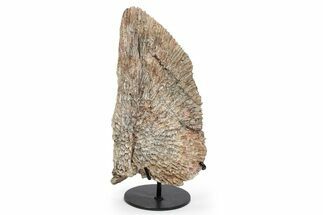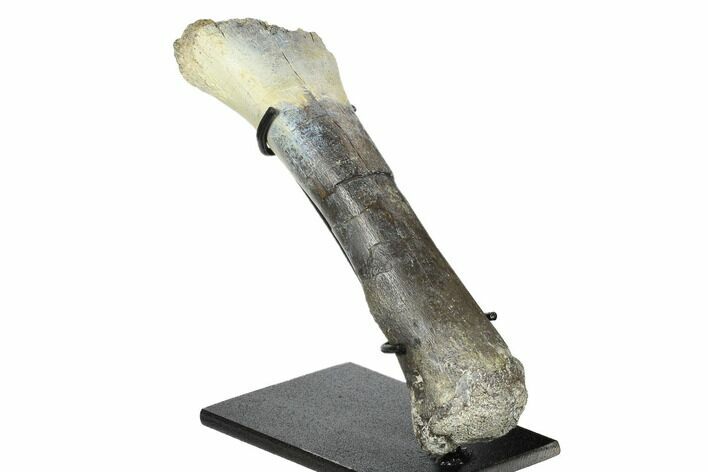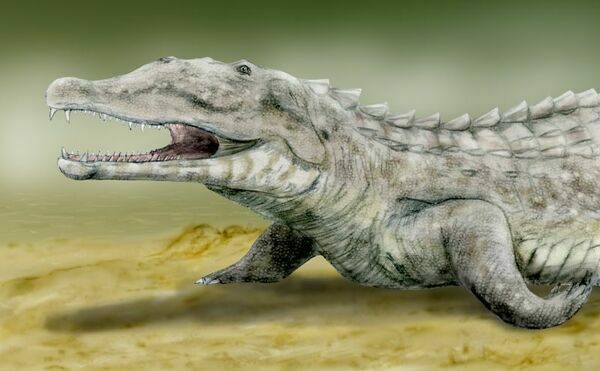This Specimen has been sold.
7.5" Fossil Phytosaur Tibia on Metal Stand - Arizona
This is a well preserved, 7.5" long Phytosaur tibia that was collected from the Upper Triassic age Chinle Formation of Northeast Arizona. Both the proximal and distal ends of the bone are weathered, with the proximal end featuring a white coloration that's likely a result of sun bleaching. There are multiple repaired cracks through the diaphysis, one of which required some gap fill restoration. The other spot that required gap fill restoration is at a break between the proximal metaphysis and the diaphysis. Much of the cortical bone is still intact, revealing the bumpy origin and insertion points of tendons. This gorgeous bone displays nicely on the included custom metal display stand.
There are a variety of phytosaurids that come from this location, making it difficult to conclusively identify individual bones to a specific genus.
There are a variety of phytosaurids that come from this location, making it difficult to conclusively identify individual bones to a specific genus.
Phytosaurs are members of the order Phytosauria. These were semiaquatic, crocodile-like reptiles characterized by long snouts, conical teeth, short legs, heavy tails, and long, low-slung bodies. They also had skin armored with scale-like scutes. However, Phytosaurs are not related to modern Crocodilians. The similarities are an example of parallel evolution, where two different species develop similar characteristics and attributes without a common ancestor.
It is not clearly understood when Phytosaurus evolved, but a number of apparently antecedent species have been found in the fossil record: their relationship to Phytosaurs is still debated. Phytosaurus disappears from the fossil record during the Triassic-Jurassic Extinction, about 200 million years ago.
Generally, Phytosaurs looked like modern crocodilians. Some species had longer, thinner snouts with thin conical teeth for catching fish, while others had comparatively shorter, wider snouts with conical teeth in the front and ripping teeth in the back of the mouth. These were likely ambush hunters that snatched prey at the water’s edge, much like modern crocodiles. The longest known Phytosaur was 39 feet long and would have been about as tall as a human at the top of its back. Unlike modern Crocodilians, whose nostrils are at the end of their snouts, Phytosauria had their nostrils at the bases of their snouts, just above or at the same level as their eyes.
Phytosaurs were nearly globally distributed. The result is phytosaur fossils have been found in Europe, North America, India, Thailand, Brazil, Greenland and even Antarctica.
It is not clearly understood when Phytosaurus evolved, but a number of apparently antecedent species have been found in the fossil record: their relationship to Phytosaurs is still debated. Phytosaurus disappears from the fossil record during the Triassic-Jurassic Extinction, about 200 million years ago.
Generally, Phytosaurs looked like modern crocodilians. Some species had longer, thinner snouts with thin conical teeth for catching fish, while others had comparatively shorter, wider snouts with conical teeth in the front and ripping teeth in the back of the mouth. These were likely ambush hunters that snatched prey at the water’s edge, much like modern crocodiles. The longest known Phytosaur was 39 feet long and would have been about as tall as a human at the top of its back. Unlike modern Crocodilians, whose nostrils are at the end of their snouts, Phytosauria had their nostrils at the bases of their snouts, just above or at the same level as their eyes.
Phytosaurs were nearly globally distributed. The result is phytosaur fossils have been found in Europe, North America, India, Thailand, Brazil, Greenland and even Antarctica.
SPECIES
Unidentified Phytosaur
LOCATION
Private Ranch, Northeast Arizona
FORMATION
Chinle Formation
SIZE
7.5" Long, 2.1" wide, 5.9" tall on stand
CATEGORY
SUB CATEGORY
ITEM
#173483
We guarantee the authenticity of all of our specimens.
 Reviews
Reviews















